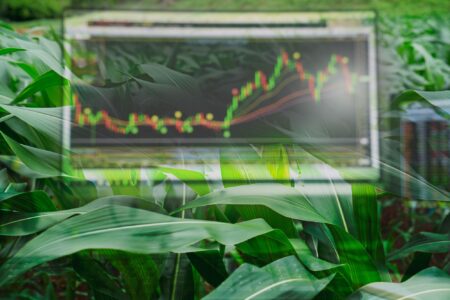By Morgan Chilson
TOPEKA — Kim Barnes scoured 52 years of contacts in his Rolodex to find buyers for 1.7 million bushels of last year’s grain sorghum crop after a cut in federal programs and international trade left the market in chaos.
This month, 1 million bushels of sorghum, commonly called milo, are leaving the Pawnee County Co-Op in Larned by rail, but those sales of last year’s product are taking a bite out of this year’s upcoming crop sales, said Barnes, the co-op’s chief financial officer.
Like many in agriculture, Barnes is worried about milo sales and how Kansas farmers will earn profits in diminished markets amid increasing costs to farm.
Along with tariffs and trade wars, the Trump administration cut the U.S. Agency for International Development program that distributed food abroad. The move eliminated one market for Kansas grains.
At 70 years old, Barnes has a solid grasp on the history of agriculture, and while he remembers tough times, what’s happening right now stands out.
“If we go back to 2016, wheat was $2.88 a bushel. Corn was $2.82 a bushel, and soybeans were $8.90 a bushel, and milo was $4.32 a hundredweight,” Barnes said. “Then you jump into 2022. Wheat was $8.48 at the end of the year. Milo was $12.82 a hundredweight. Corn was $7.88 a bushel and soybeans were $14.94.”
Today, the picture is grim. Barnes said wheat sits at $4.22 per bushel, milo is $5.71 a hundredweight, corn is $3.90 per bushel, and soybeans are $9.34 per bushel.
Prices are low at a time when Kansas farmers are having an excellent crop after a summer of good weather, said Andy Hineman, vice president of the Kansas Grain Sorghum Producers Association and a fifth-generation farmer in Dighton.
“It’s going to be a tremendous crop for much of the sorghum growing area,” he said. “The prediction on production this year is 9.9 million metric tons (in the United States). Normally, we’ve been around 10 million.”
Kansas farmers produce about half of the crop, Hineman said.
International Trade
Typically, about 60% of the milo crop is exported, with 90% of the exports going to China, according to a sorghum association spokesman. But almost all of the China market has been lost.
“There’s a lot of work being done on improving domestic use of milo and improving additional markets,” Hineman said. “In the past, a lot of our milo exports have gone to China, and so not having them as a trade partner right now is definitely a challenge that I think we’re all concerned about.”
Mexico and India are markets for potential milo sales, he said. In addition, options are available domestically, and Hineman noted a recent U.S. Food and Drug Administration study is looking at milo for human consumption.
“Historically, it’s been more of a feed crop and ethanol crop, but there are some smaller mills that do produce milo flour and sorghum food,” Hineman said. “But it’s the first time the FDA is getting behind it and doing a study, so that’s really exciting to see.”
Nick Levendofsky, executive director of the Kansas Farmers Union, agreed that new markets must be found.
“If China is shutting the door on us, we’ve got to find an opening somewhere,” he said. “That, to me, right now speaks to India.”
Gregg Ibendahl, associate professor in agricultural economics at Kansas State University, said it’s difficult to predict where future markets might be but that tariffs and shifting global trade may upend the United States’ international role.
“South America is becoming, technology wise, probably almost as good as we are when it comes to growing a lot of crops,” he said. “It wouldn’t surprise me if South America really would become the low-cost leader in producing grain. Are we going to still be the primary supplier? Are we going to be a secondary supplier?”
At this stage, it’s difficult to tell how tariffs will affect the country’s position, he said.
Barnes is working to make connections to make sure the next milo crop out of the fields won’t be stored for long. He’s traveling to San Antonio soon to participate in a commodity conference where he’ll be able to sit down with international buyers.
He went to a pet food forum in Kansas City recently, something he’d never attended before but that he believed might offer grain sales.
“I was taught to dream and taught to look for the silver lining, and so that’s where I’m at today,” he said. “It’s been a challenge, but a good challenge. In other words, we’re not waiting for the world to come to us. We’re out beating the bush, trying to make the sales and not waiting for somebody else to come to our door. We’re out marketing ourselves.”
Local Impacts
When farm income drops, it not only jeopardizes farm operations but the entire community, Barnes said.
Local businesses struggle when agricultural income and spending drop.
Barnes said the co-op pays $3.8 million in property tax, more than $34 million in labor and that studies have shown every dollar generated in agriculture is multiplied seven times in the local community.
Levendofsky said he spoke to a banker who was only making agricultural loans secured by land, something the long-time farmer said he doesn’t remember happening before.
Kevin Swayne, president and CEO at High Plains Farm Credit, said his company isn’t taking those kinds of steps.
“Obviously there’s some more challenging times, rising input costs and lower commodity prices, which is tightening up margins and putting pressure on a lot of operations, especially in Kansas,” he said. “That’s always going to understandably raise concerns about access to credit and financial support.”
Each bank sets its own lending underwriting standards and risk profiles, Swayne said.
“We keep a list of those loans that get denied and are delinquent even, and so far our delinquencies have stayed very manageable and are not spiking yet. It’s my understanding in the industry that you’re starting to see some of that,” Swayne said.
High Plains’ philosophy is to partner with customers, and Swayne said they work with farmers to develop a plan that includes commodity price assumptions and government payments, as well as whether they use crop insurance to manage risk.
Kansas Reflector is part of the States Newsroom, a network of similar news bureaus supported by grants and a coalition of donors as a 501c(3) public charity.


:max_bytes(150000):strip_icc()/Iowa-State-Fair-Banner-d22e8c0989b142aabefb048e52d85521.jpg)




:max_bytes(150000):strip_icc()/13973276071_5d61aaebbc_o-07153824be3147608b38c3330da5b4f8.jpeg)



:max_bytes(150000):strip_icc()/2210-08-097_wheat-269350b0a9c64faa985d0ba927488669.jpg)
